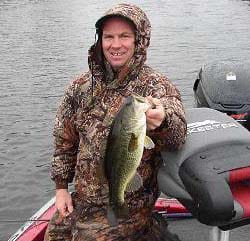Higher Water Level Keeps Bass Shallower On Lake Murray Through The Winter
Historically, when winter descended on Lake Murray in South Carolina, bass anglers moved out to the drops on the main lake and fished deep with jigs, but that is no longer the situation, said veteran tournament angler and retired bass guide Doug Lown of Newberry, S.C.
“Since they started holding the water level higher in the winter months we don’t seem to catch as many fish out on the main lake on the deep drops as we used to,” Lown said. “The fish seem to move in closer to the little bays and ditches and some even get back in the creeks now.”
December, January and February are generally considered the winter season on Lake Murray, he said, with the fall season still predominant in early December and the pre-spawn season starting to kick in by about mid-February.
The other factor that has changed bass fishing drastically – and not just in the winter – is the increased prevalence of blueback herring, Lown said.
“The fish feed on bait now so you don’t catch as many on a jig or typical bottom type stuff that you would normally fish in the winter. You can still catch fish on a Shakey Head, but the primary bite on Lake Murray – and on all lakes with herring – is a baitfish bite.
“You can catch them in clear water early in the day, but I look for water that has a little more color to it, in the mid and upper lake. The fish seem to bite a little longer during the day back in the creeks there.”
When the water temperature drops down into the mid-40-degree range, Lown said the bass seem to suspend and can be caught fairly shallow on a jerkbait early in the morning on rocky points with the wind blowing on them.
“The jerkbait seems to work really good if the water temperature is below 47-48 degrees. From Bear Creek and the Shull Island area down to the dam the water is really clear, so you have to have the wind. If there is no wind, I don’t bother to go down there.”
If the water temperature gets really cold, Lown said, some fish can still be caught on a jigging spoon – but you have to find them.
“You have to use your electronics to find the balls of bait. The last drop at the end of extended shallow points is usually where you locate the fish in 35 to 40 feet of water. You can find some fish close to the bottom around the bait.”
The primary tactics for bass on Lake Murray from December through February, with January normally the coldest month of the year, are crankbaits and jerkbaits, with some caught on a jig, Lown said. By late January, he noted, the larger fish will begin to move in and stage close to where they are going to pull in to spawn later. Those fish will continue to feed.
“It’s almost a pre-spawn period. You start getting some warmer days, especially in the latter part of February and the fish will start staging up on little secondary points. Sometimes there will be an early morning bite and, gradually if there are some warmer days, some fish will pull up on docks and start relating to cover around the banks.”
That movement towards the banks will happen even if colder weather prevails through the end of February, Lown said, because the fish instinctively begin their journey towards the spawn as the days get longer.
“The fish key in on the photo period. As it gets longer they know it and start moving in and staging close to where they are going to spawn,” Lown said. “I generally start looking in creeks, bays and short pockets off the main lake at that time. It is the same all over the lake, although the spawn usually occurs earlier down the lake in the clearer water and a little later in the upper lake where the water is a little dingier.”
Crankbaits come into play once the water temperature rises into the upper 50s and low 60s, he said, and some can also be caught during this period on a Shakey Head worked on secondary points.


















Comments are closed.